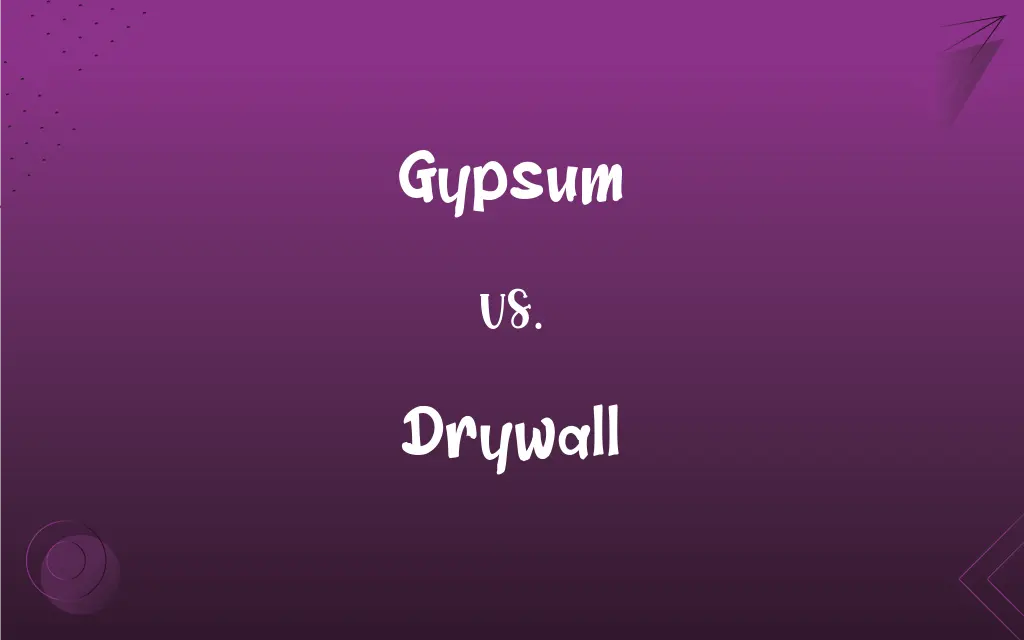Gypsum vs. Drywall: What's the Difference?
By Janet White || Published on December 24, 2023
Gypsum is a natural mineral used in many industries, while drywall refers to a construction material made from gypsum plaster between two sheets of paper.

Key Differences
Gypsum is a soft sulfate mineral composed of calcium sulfate dihydrate. It's found in nature and is used in various industries, including construction. Drywall, on the other hand, is a specific construction material made by placing a layer of gypsum plaster between two sheets of paper. It's commonly used for interior walls and ceilings.
In its raw form, gypsum is a translucent, crystalline mineral often mined from sedimentary rock formations. It's processed into a powder and used in various products. Drywall utilizes gypsum in a processed form, mixing it with additives to produce a plaster that hardens between paper sheets, creating panels for construction.
Gypsum has various applications beyond construction, such as in agriculture for soil conditioning and as a food additive. Drywall specifically refers to the construction panels made from gypsum plaster. These panels are cut to size and used to create smooth, paintable interior surfaces in buildings.
The versatility of gypsum makes it valuable in industries like art, where it's used for sculptures and molds, and in medicine for casts. Drywall, however, is solely a construction material, valued for its fire resistance and ease of installation in residential and commercial structures.
Gypsum's physical properties include being soft, able to be scratched with a fingernail, and having a white or colorless appearance. Drywall exhibits different properties, such as rigidity, smoothness, and being easily cut and fastened to framing in buildings, showcasing the transformation of gypsum into a practical building material.
ADVERTISEMENT
Comparison Chart
Composition
Natural mineral composed of calcium sulfate dihydrate
Construction panels made from gypsum plaster and paper sheets
Raw Form
Translucent, crystalline mineral
Manufactured, rigid panels
Uses
Diverse, including agriculture, art, and medicine
Primarily for constructing interior walls and ceilings
Properties
Soft, can be scratched with a fingernail, white/colorless
Rigid, smooth, easily cut and fastened
Industry Relevance
Broad application in various industries
Specific to the construction industry
ADVERTISEMENT
Gypsum and Drywall Definitions
Gypsum
Gypsum is a soft mineral widely used in construction and agriculture.
The gypsum deposits were extensive, promising a steady supply for construction projects.
Drywall
Drywall is known for its ease of installation and finishing.
The contractor preferred drywall for its quick installation time.
Gypsum
Gypsum is a raw material for making plaster and drywall.
The factory processes gypsum into plaster for various construction applications.
Drywall
Drywall consists of gypsum plaster sandwiched between paper sheets.
The drywall panels made the renovation process faster and cleaner.
Gypsum
Gypsum serves as a fertilizer and soil conditioner in agriculture.
Farmers use gypsum to improve soil composition and promote healthy crop growth.
Drywall
Drywall is a construction material for creating interior walls and ceilings.
They installed drywall throughout the new office building.
Gypsum
Gypsum is a naturally occurring crystal used in art and medicine.
Artists often use gypsum for creating detailed sculptures.
Drywall
Drywall is a cost-effective alternative to traditional plaster walls.
To reduce costs, the builders used drywall instead of plaster.
Gypsum
Gypsum is known for its fire-resistant properties.
Gypsum boards were chosen for the building due to their excellent fire resistance.
Drywall
Drywall provides a smooth, paintable surface in buildings.
Once the drywall was up, they could start painting the rooms.
Gypsum
A widespread colorless, white, or yellowish mineral, CaSO4·2H2O, used in the manufacture of plaster of Paris, various plaster products, and fertilizers.
Drywall
A building material consisting of rectangular sections usually made of a gypsum plaster core bonded between layers of heavy paper, used especially in the construction of interior walls and ceilings. Also called gypsum board, plasterboard, wallboard.
Gypsum
A mineral consisting of hydrated calcium sulphate. When calcinated, it forms plaster of Paris.
Drywall
Also dry wall A wall constructed from rocks that are not cemented together.
Gypsum
A mineral consisting of the hydrous sulphate of lime (calcium). When calcined, it forms plaster of Paris. Selenite is a transparent, crystalline variety; alabaster, a fine, white, massive variety.
Gypsum
A common white or colorless mineral (hydrated calcium sulphate) used to make cements and plasters (especially plaster of Paris)
FAQs
How is gypsum used in construction?
Gypsum is processed into plaster and used in drywall and other building materials.
Can gypsum be used in art?
Yes, gypsum is used for sculptures and molds in art.
What is gypsum?
Gypsum is a natural mineral used in construction, agriculture, and other industries.
Is drywall environmentally friendly?
Drywall is relatively eco-friendly, often made from recycled materials and being recyclable.
What are the benefits of using drywall?
Drywall is fire-resistant, easy to install, and provides a smooth surface for painting.
Can gypsum be used in agriculture?
Yes, gypsum is used as a soil conditioner and fertilizer in agriculture.
What are the properties of gypsum?
Gypsum is soft, can be scratched with a fingernail, and is typically white or colorless.
How is drywall installed?
Drywall panels are cut to size and fastened to the framing of a building.
What is drywall?
Drywall is a construction material made from gypsum plaster between two paper sheets.
Is drywall easy to repair?
Yes, drywall can be easily patched and repaired if damaged.
Is gypsum recyclable?
Yes, gypsum can be recycled and used in various applications.
Is gypsum suitable for outdoor use?
Gypsum is primarily used indoors; its use outdoors requires special treatment for weather resistance.
How does drywall contribute to building insulation?
Drywall itself has minimal insulation properties but contributes to the overall insulation system.
Can gypsum be used in medicine?
Yes, gypsum is used for making casts in medicine.
How is gypsum processed for construction use?
Gypsum is ground into a powder and mixed with additives to make plaster.
What are the advantages of drywall over traditional plaster?
Drywall is quicker to install, less labor-intensive, and more cost-effective than traditional plaster.
How does drywall affect indoor air quality?
Quality drywall does not significantly affect indoor air quality and is considered safe for indoor use.
Are there different types of drywall?
Yes, drywall comes in various types, including moisture-resistant and fire-resistant.
Can drywall be used in high-moisture areas?
Special moisture-resistant drywall is suitable for high-moisture areas.
Is gypsum fire-resistant?
Yes, gypsum has natural fire-resistant properties.
About Author
Written by
Janet WhiteJanet White has been an esteemed writer and blogger for Difference Wiki. Holding a Master's degree in Science and Medical Journalism from the prestigious Boston University, she has consistently demonstrated her expertise and passion for her field. When she's not immersed in her work, Janet relishes her time exercising, delving into a good book, and cherishing moments with friends and family.
































































